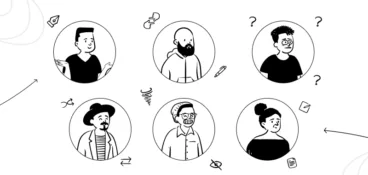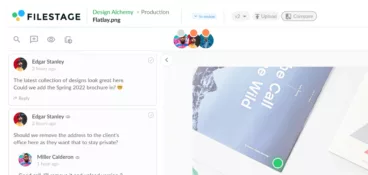Which factor do you believe is the most critical to the success of your project?
Perhaps you think it’s the people on your team, the tools that you use, or the resources that you have available to you.
We’d argue that although those elements are undoubtedly critical, a project management communication plan is the single most important factor. That’s why project managers spend an estimated 90% of their time communicating, over the course of the average project life cycle.
That’s a pretty bold statement, but if you think about it, you’ll agree that you won’t even get your project off the ground without impeccable communication. What’s more, your team members won’t be able to work effectively or monitor project progress if they can’t communicate.
That’s why it’s critical to underpin your project with a solid project management communication plan.
In this post, we’ll take you through the steps that you should follow to optimize your project communications.
Supercharge your content reviews
Share, review, and approve all your content in one place with Filestage.
What Is a Project Communication Plan (and Why is it Useful)?
A project communication plan is a critical resource that helps project stakeholders to communicate clearly and effectively with one another.
The communication plan achieves this by establishing clear guidelines for factors, such as:
- What information should be shared
- When information should be shared
- How information should be shared
- Whom information should be shared with
- Who is responsible for sharing information
And, of course, great project communication plans bring great benefits. We’ve listed them below.
Move projects forward
Project delays are often caused by breakdowns in communication. All too often, your project members have their work or feedback ready, but they struggle to get in touch with the right colleague(s).
A project communication plan smoothes out those issues. When they’re equipped with a plan, your team members will know right away when, how and with whom to communicate.
Boost accountability
Delays and issues with complex projects can often come down to something as simple as a missed phone call or an overlooked email. That can be a frustrating experience and one that has a knock-on effect on your project. This is especially true when your project involves more than just a few people:
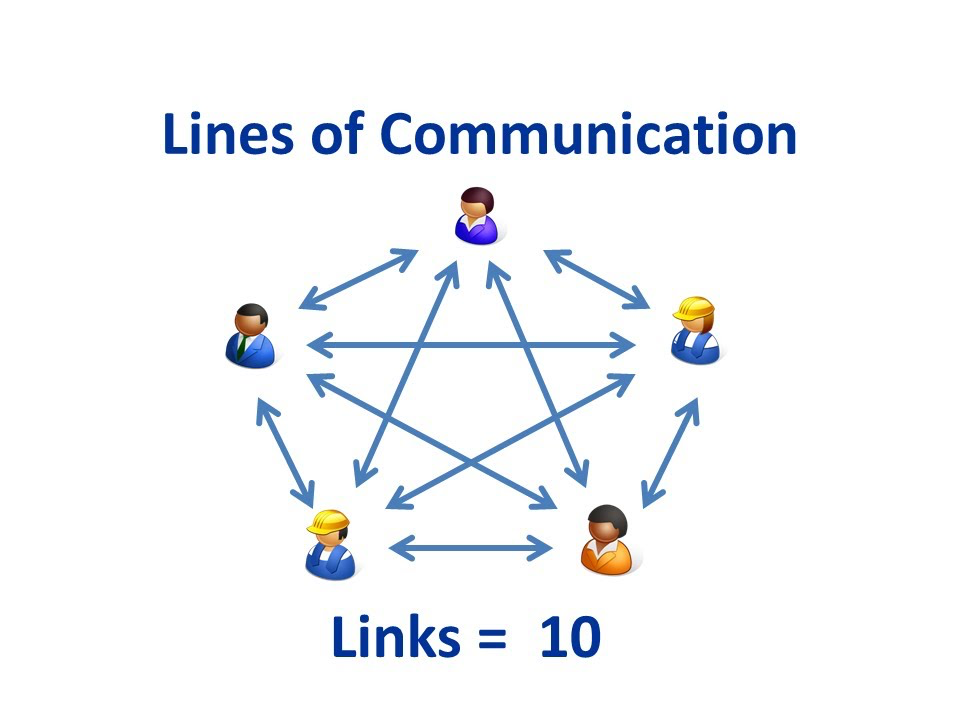
(Source: Sir Ganntalot)
A project communication plan ensures that everybody is reading from the same script. This boosts accountability over the course of your project and ensures that everybody operates effectively.
Elevate transparency
The efficiency of a project can be harmed if a certain project team member is left out of the loop. This will cause significant delays and inefficiency, so it’s important that project managers consider stakeholder management from the start as part of their communication plan.
An open and easily understandable communication plan helps to guarantee that the right information is always shared with the right people. This boosts transparency and, ultimately, results.
Content Project Communication Pitfalls
When you need to create a piece of content, it’s very important that you create a robust communication plan that helps you to avoid the following common pitfalls:
1. Imprecise feedback
You have been tasked with producing a piece of high-quality content, and you need to engage a number of roles. This means that you could find yourself working with a mix of skilled people, such as copywriters, designers, animators, and more.
Solution: Use the correct project collaboration tools to make it easy for your stakeholders to leave precise feedback for your creative team members. This avoids confusion and empowers the creative professionals to work as efficiently as possible and to produce the best results.
2. Engaging the wrong stakeholders
When you created your project timeline, you probably identified a number of key stakeholders to be responsible for the review and approval of your content. However, that list of stakeholders may well change over the course of your project, as you add and remove people..
Solution: It’s important that you stay on top of your list and engage the right stakeholders at the right time. You can use a stakeholder matrix to do this. This will keep communication flowing as harmoniously as possible and you’ll be able to fuel your creative professionals with quality feedback.
3. Poor version control
Poor-quality version control means that various members of your team may find themselves working on different documents. This can throw your communication into complete disarray and cause a lot of crossed wires.
Solution: In order to produce high-quality project deliverables, it’s critical to exercise flawless version control to keep your team members on the same page and working in harmony. A dedicated review and approval tool helps you to do this.
4. Long email threads
Long email threads, m during the review and approval phase of a project, are a nightmare for any team. Those threads can quickly snowball out of control, making it impossible for your team members to track communication effectively. This can create a great deal of inefficiency and issues with version control.
Solution: It’s best to use a dedicated review and approval tool. These tools can mean that you are able to reserve email for only the most important pieces of information.
Project Communication Channels and Methods You Can Use
It might seem obvious to say that the communication channels and methods you use are critical to achieving marketing project management success. However, it’s always very useful to have a closer look at what’s out there. Here’s a comprehensive overview of the key project communication channels and methods.
1. Email

According to a report from Radicati, the average American worker receives an estimated 126 emails each day. That’s a huge number, but it’s a testament to the efficacy of the channel.
Personal Email
More important than a chat message, but less intrusive than a face-to-face meeting – a personal email is a great way to share an important piece of information with a team member on your project.
Group Email
Group emails are easy to dispatch and they’re a great way of sharing important information with everybody on your project. Emails are often easier to find than direct messages, as well, which makes them very practical.
Newsletter
Newsletters are group emails, dispatched on a regular basis. They often contain a wealth of information. Your project participants will anticipate their arrival, and they help to harmonize communication on your project.
2. Face-to-Face
Meetings are still multiplying, with an average of 55 million meetings taking place per week in the USA alone. These face-to-face meetings are a great way to build strong links between your project team members and ensure nothing is lost in terms of key messages.
1-on-1 Meeting
A 1-on-1 meeting is a great opportunity to connect with a particular team member and to solve a challenge quickly. Meeting someone face-to-face can be much faster than other communication methods and it’s often more accurate.
Group Meetings
Group meetings are an essential part of any project. These meetings give the entire team the chance to share their progress and to disclose dependencies or potential challenges. Group meetings can be hosted on a daily or weekly basis, you choose!.
3. Phone
Phone calls between project team members are a fast and efficient way of getting an immediate answer to a query or question. They’re more immediate and direct than emails, but they aren’t quite as intrusive as an impromptu face-to-face meeting.
1-on-1 Phone Call
A 1-on-1 phone call is often the fastest way to connect with another team member and to get a quick answer. These calls can be scheduled or spontaneous – it depends entirely on your communication culture.
Phone Conference
Teleconferences are a popular communication method for large teams that are spread out remotely. This is often the go-to method for letting remote teams catch up, on a regular basis and for sharing project updates.
4. Software
Depending on the tech stack that you’re using, you might have software-specific communications’ options available to you. Tools such as Jira, for instance, permit users to share messages and updates with one another.
Project management tools such as Asana and Filestage also empower users to tag one another and to leave various notes and messages.
5. Instant Messaging
An impressive number of business messaging apps, on the market, have cemented themselves as critical tools within a number of businesses. Tools such as Slack, Flock, and Microsoft Teams are empowering teams to be more productive and to uplift their communication.

Private Message
Private messages are a great way for team members to quickly ping one another and/or to collaborate on particular tasks. As ever, it’s important to try to reduce the temptation for your team members to use this channel too much.
Group Message
Group messages are a great communication method, which project managers can use to dispatch project-wide updates quickly. They also provide a great space to share daily updates within specific teams.
Note
Instant messaging platforms can also be used by team members to leave quick notes. These small reminders or updates aren’t as pressing as emails, and they can be addressed when they’re seen.
Automated Notification
The most sophisticated instant messaging platforms offer a number of integrations and cutting-edge functionality. These platforms can be used to automate notifications or to schedule messages, giving project managers the power to manage their updates better.
6. Project Management and Collaboration
The acts of project management and collaboration, themselves, are another opportunity for communication between your team members. Here’s a look at some actions you can take and what they communicate.
New Task or Project
If you spin up a new task or project, using a project management tool, it’ll often dispatch a notification to the stakeholders who are involved. This will immediately alert them and inspire them to act.
Comment on Task or Project
Project management tools often make it possible to leave comments on tasks and projects. You can use those comments to centralize your communication and to keep it in a public space for all of your stakeholders to see.
New File Upload
If you upload or create a new file, it’s important that your stakeholders are able to see this. Cloud storage services such as Dropbox and Google Drive allow you to share notifications and updates with users.
New Report
Reports communicate important information to the team. Many project management tools will automatically generate reports, which contain rich insights and conclusions for the team.
File Review
Platforms such as Filestage make it possible for your stakeholders to review files in one location. This centralized space ensures communication and feedback remain in one place, keeping everyone in the loop.

Approval
Whenever a stakeholder approves a piece of content, they’re communicating their satisfaction and belief that everything is good to go. Once again, platforms such as Filestage make it simple to track the approval status of your marketing collateral.
Supercharge your content reviews
Share, review, and approve all your content in one place with Filestage.
7. Video Conferencing

Video conferencing tools help remote teams to communicate efficiently and build relationships. In fact, today, 78% of teams rely on video for team meetings and stand ups.
Private Video Conference
Private video conferences give two individuals the chance to connect and share updates over vast distances. This communication method helps individuals to build relationships and to communicate effectively.
Group Video Conference
Group video conferences get a large number of project stakeholders involved at one time. Group video conferences create a community feel and give project managers the ability to share updates and information efficiently.
Developing Your Own Project Communication Plan: Here’s How it’s Done
Now that we have a clearer understanding of why you should develop a project communication plan, the pitfalls to avoid, and the communication channels and methods you can use, let’s explore the five steps you should follow to create your own project communication plan.
1. Set Your Objectives
Your first step is to outline the purpose and goals of your project communication plan clearly. Ensure you articulate them in a clear statement.
Then, use that statement to open and introduce your project communication plan. This will answer any questions from your stakeholders and will emphasize just how important your communication plan is – this will help you to guarantee that it’s used properly.
Here’s an example of how one company decided to begin its communication plan:

2. Create a List of Stakeholders
Now that you’ve clearly outlined your objectives, it’s time to create a comprehensive list of stakeholders.
This list will help you gain a clearer picture of who is involved in your project and how you should communicate with them. It’s important that – at a minimum – your stakeholder lists includes fields such as:
- Name
- Position
- Communication channel
- Communication method
- Relevant notes
You might want to ask each stakeholder about their preferred communication method, so that they know when and how to expect updates from you.
This list of stakeholders doesn’t have to be ultra-sophisticated. Their preferences might also change over the course of the project, so it’s important that it’s flexible. Here’s what that list of stakeholders might look like, using a simple Google Sheets template:

If you want to learn more about this step, be sure to read our piece on how to build a solid stakeholder management plan.
3. List Your Communication Channels
Before you begin your project, it’s very important to audit the communication channels that you have available to you.
You could start by using the list of project communication channels and methods that we outlined above. Try to give yourself a spread of options that will satisfy the needs of everybody on your project.
You’ll also want to take your teams’ existing communication preferences into account. For example, look back at what has worked well in the past, and, at the same time, use the new project as an opportunity to overcome any previous communication issues.
When you’re selecting the appropriate communication channels, you’ll want to think very carefully about the pros and cons of each. Instant messages are fast and direct, for example, but they’re not the best way to share important updates with multiple team members.
4. Decide What to Communicate
Once you’ve got a better idea about your project and what you’re hoping to achieve, you’ll find it easier to develop a communication plan.
Let’s say that you’re managing a complex marketing project with around twelve members. You might decide that, for this project, you’ll share the following pieces of information:
- Daily updates with the core team
- Weekly progress reports with the management team
- Monthly in-person project updates with the executive team
If you decide what to communicate and when, beforehand, you’ll find it easier to prepare and perform your own work effectively. For example, you’ll be able to schedule those upcoming updates into your own calendar, as well as with whom you’ll need to share them..
5. Answer Key Questions for Each Communication
Before you dispatch any update or project communication, go through the following checklist. Working through this list methodically is a great way to make sure that all of your communications are relevant and effective.
Set your objectives
Decide exactly why you are sending this communication and what you hope to achieve. Here’s an example:
“I need to update our marketing manager on the status of our project.”
Determine the frequency
Think about what frequency makes sense. This will help you to communicate as effectively as possible and to achieve your goal.
Re-using our example from above, you might decide to dispatch that update on a weekly basis.
Choose your communication channel
Now that you’ve decided why you’re going to send a message and when, you’ll want to find the perfect channel.
Using our example, you might decide that email is the most appropriate channel, given that it’s formal, you can attach a range of reports, and emails are easier to catalogue.
Choose your communication method
Once you’ve chosen the channel, you’ll need to go one step deeper and select the appropriate method.
Going back to our example; you might decide to send that weekly update as a one-to-one email.
Determine your audience
Clarify to whom exactly you are sending the communication. Think carefully about whether somebody else on your team could benefit from this communication and if they need to be kept in the loop.
Decide on an owner
You might decide not to dispatch the communication yourself. For example, you might decide to set this weekly communication up yourself, but to have your graphic design lead send it to the marketing manager.
We’ve created a free project communication plan template just for you. Please feel free to save your own copy, to start editing and harmonizing communication across your project.
5 Project Communication Plan Examples
Are you looking for some inspiration to build your project communication plan? There are lots of examples and project plan templates out there that you can use.
Let’s take a closer look at five of the best examples, and discover what they do so well.
1. Division of Information Technology
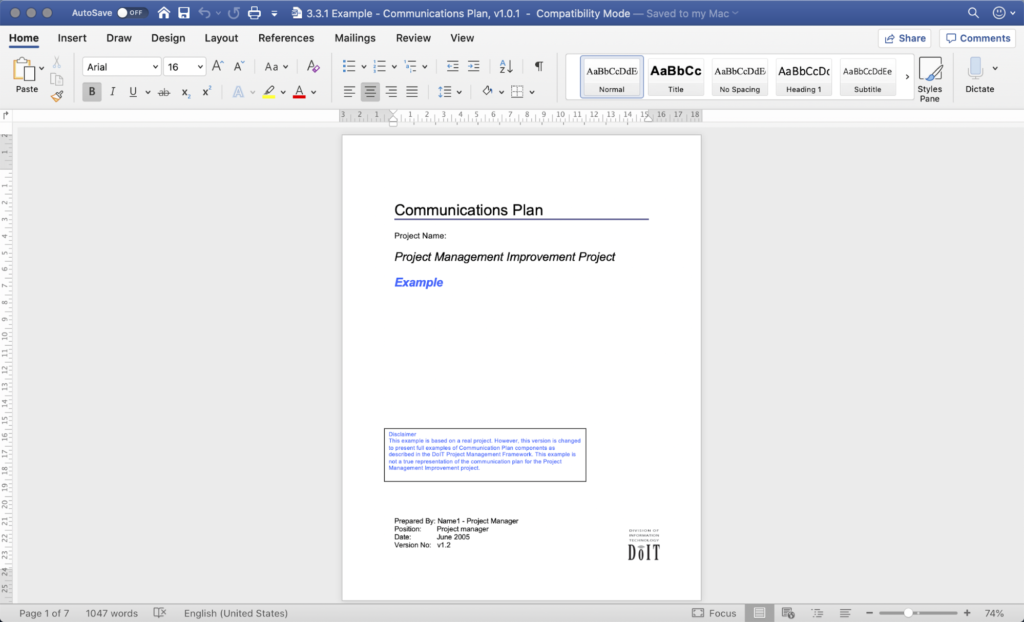
This project communication plan example comes to us from the Division of Information Technology.
This is a great example of a well-organized project communication plan. The structure is clearly outlined and the message and delivery section painstakingly outlines which stakeholders should receive which communications, when, and via which channel.
The appendix also does a nice job of organizing the target audience participants, to drive transparency for the entire team.
2. Simplicable Communication Plan Example

This sample communication plan from Simplicable gives you a good idea of how a project manager might decide to organize their key communications, over the course of a project.
In the above example, the organizer has adopted a chronological approach, allowing the project manager to see what has to be prepared next, at a glance. We like that the goals for each communication are clearly outlined and that the audience list is so comprehensive.
3. ProjectManager Communication Calendar

This communication calendar from ProjectManager shows how a project manager might organize their communication plan, within their own calendar. The use of color-coded events makes it simple to see who needs to receive which communication and when.
This calendar could also even be shared publicly, with the rest of the team, so that they know when to expect updates and through which channel.
4. Intuit Project Communication Plan
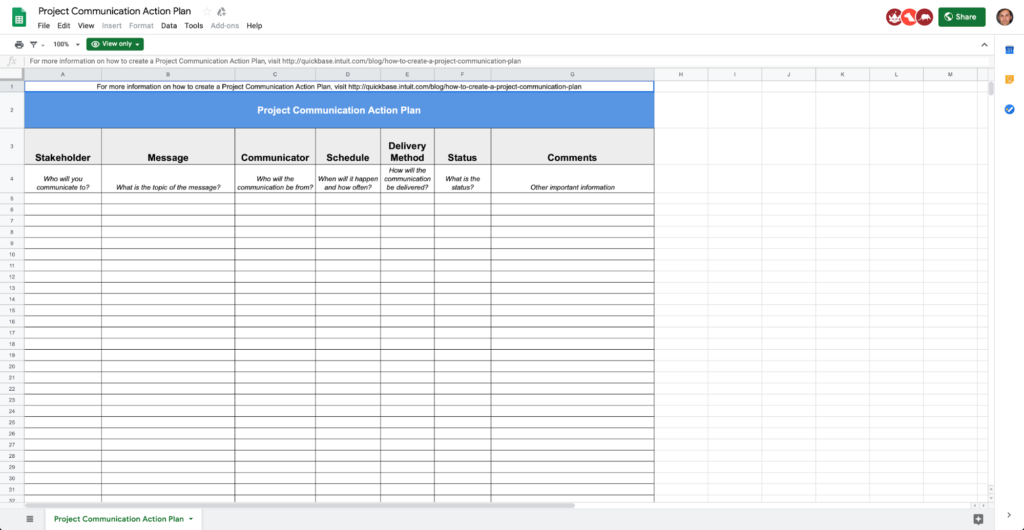
This simple project communication plan from Intuit is a great resource. It’s a simple Google Sheets template that you can copy and adjust to your own needs. You’ll find all of the key fields in it.
If you want to spin up a communication plan for your new project quickly, you’ll want to make the most of this resource.
5. ProjectManagementDocs Communication Requirements Table
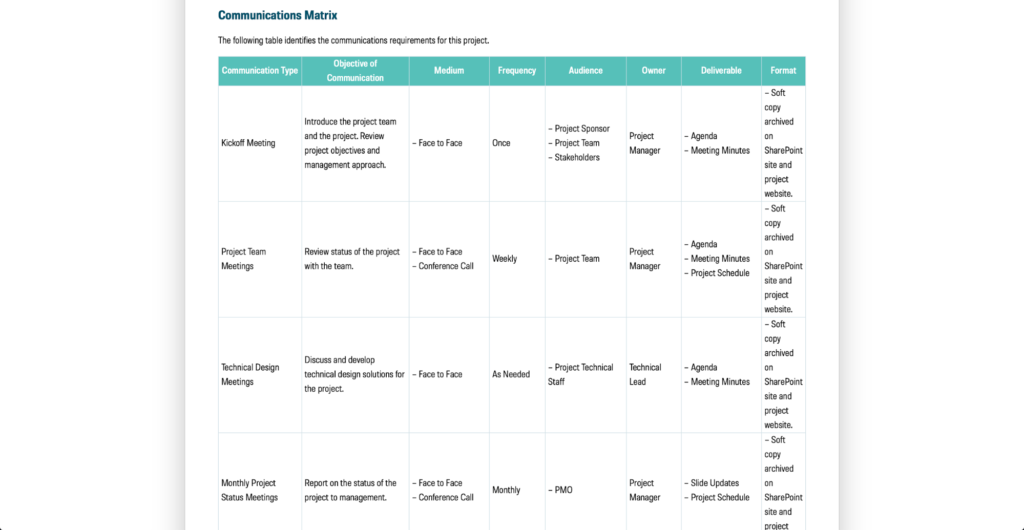
This communications requirement table from ProjectManagementDocs is a great place to get some inspiration for your own project communication plan. It’s a great example of how to structure your information and what to include.
7 Project Communication Best Practices
Now that you’ve got an idea of how to put together a project communication plan, let’s take a look at some best practice tips that you should keep in mind along the way.
1. Build a strong communication culture
“Your company culture plays an important role in cultivating good communication practices. As a project manager, do your bit to build a culture where ideas and opinions are welcomed with open minds along with a focus on face-to-face conversations and social interactions.”
Vartika Kashyap, ProofHub (BrightWork)
Right from the very beginning of your project, it’s important that you foster an open culture, which inspires your team members to engage.
2. Share your communication plan widely
“Think of consolidating all project-related information into a centralized knowledge base. Anyone working in project management related roles should be able to freely access this information.”
Sylvia Moses, Workamajig
Your project communication plan is effectively useless, if nobody can access it when they need to confirm something. Make sure it’s easily accessible.
3. Carefully plan your meetings
“Meetings have a bad reputation. Why? Bad meetings are poorly planned and facilitated resulting in a huge waste of time. I’m not in the camp of getting rid of meetings. However, I am for reducing the number of meetings and the time spent in meetings.”
Harry Hall, Project Risk Coach
Plan your meetings carefully to ensure that they are a source of energy for your team members rather than an opportunity for daydreaming.
4. Understand your different audiences
“It’s best not to send out emails announcing bad news. Nor is it appropriate to deliver a 75-slide presentation to an audience of two. A key component of executing an effective communication strategy is knowing exactly how to portray your message. Busy executives generally prefer high-impact, short communication efforts; conversely, your creative team needs detailed briefs. Be wise and match your medium to the message.”
David Arnold, Workamajig
As the project manager, you’ve got to lead by example, so consider your audience, first,when communicating. Always think carefully to ensure you make the right choices.
5. Plan for post-project communication
“Communication is not only vital throughout a campaign or project, but also once that project is over. Make sure you communicate what went well, and allow your team to celebrate their shared accomplishment. Of course, communication, workflow, and creativity should always be evolving, so it is also good to discuss what should change the next time around, but make sure the energy remains positive and appreciative.”
There’s still work to do, even after your final deliverable has been shared. You should already have a post-project communication strategy in place – and if not, there are a lot of project management templates that you can make good use of.
6. Audit your previous communication performance
“Measuring your efforts is key to ensuring a successful internal communication strategy. It’s what takes you from random acts of marketing to sophisticated and effective communication. Just as you wouldn’t try to shoot at a dartboard wearing a blindfold, you wouldn’t want to begin implementing a communication strategy without assessing your performance to date.”
Melinda Morella-Olson, Imaginasium
It’s critical that you learn from your previous experiences. Constantly audit what does and doesn’t work, in terms of communication, and then adjust your plan accordingly.
7. Never underestimate the power of active listening
“Communication is effectively useless if you don’t listen to and comprehend the responses you get regarding your message. Listening isn’t just using your ears to collect sounds. You need to understand the things being said to you in such a way you can form a coherent and knowledgeable response.”
Scott Rudoswki, Project Management Academy
As the project manager, you’re going to spend significant amounts of your time communicating with others. This can become tiring, but it’s critical that you engage in active listening to keep your team engaged and motivated.
Closing Thoughts
We hope that this piece helps you put together an incredible project communication plan. It’s worth your taking the time to create a truly special resource, given that it will ultimately play a huge role in making or breaking your project.
If you want to expedite your review and approval process, be sure to put Filestage in the hands of your team members, today. Our powerful platform empowers you to invite your stakeholders and lets you collect insightful feedback with just a few clicks: start your free Filestage trial.




